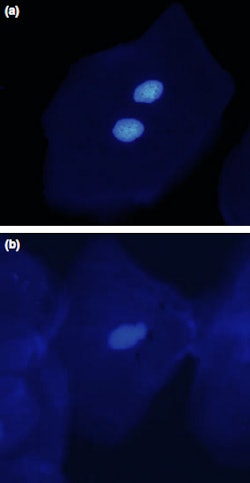
An evaluation of cell samples from the oral mucosa of mobile phone users showed no genotoxic effect from radiofrequency exposure to the devices (Oral Diseases, November 2012, Vol. 18:8, pp. 786-792).
Researchers at the University of Murcia's Morales Meseguer Hospital evaluated the biomarkers for DNA damage, cytokinetic defects, proliferative potential, and cell death due to radiofrequency (RF) radiation emitted by mobile phones in healthy young users.
The researchers chose to study the epithelial cells of the oral mucosa because they are closely exposed to the radiation of mobile phones, and because epithelial tissue is the target tissue for carcinogenetic damage.
Cellphone technology is based on electromagnetic radiation in the microwave frequency range of 300-2100 MHz. The International Commission on Non-Ionizing Radiation Protection has established guidelines for exposure limitations that have been adopted by many countries.
Biologic effects
Epidemiological studies have suggested that exposure to the low energy, ultrahigh-frequency electromagnetic field (UHF-EMF) emitted by mobile phones may have biological effects in living organisms, the researchers noted. However, studies have varied considerably in their conclusions, suggesting or denying a correlation between heavy cellphone use and headaches, migraines, brain tumors, auditory canal pathologies, and physiologic changes in the salivary glands.
For example, a nationwide case control study performed at the Gertner Institute at Chaim Sheba Medical Center found what is believed to be a link between heavy cellphone use and malignant tumors in the parotid gland (American Journal of Epidemiology, February 15, 2008, Vol. 167:4, pp. 457-467).
More recently, a study in Oral Surgery, Oral Medicine, Oral Pathology, Oral Radiology (August 2012, Vol. 114:2, pp. 200-206) found that heavy cellphone use increases the rate of saliva and flow and the volume of parotid glands.
The issue of the healthcare effects of cellphone use has even moved into legal circles. In a landmark case that could open the door to further litigation, Italy's Supreme Court ruled last month that there is a causal link between mobile phone use and brain tumors. The court sided with a businessman's doctors who blamed a noncancerous brain tumor he developed near his left ear on the electromagnetic radiation from his phone. The ruling entitles the man to workers' compensation in the form of a disability pension.
Far from a consensus
For the current study, the Spanish researchers evaluated 50 healthy Caucasian patients (16 men, 34 women), ages 20 to 40 years old. They collected two cell samples from each subject (a total of 100 cell samples), corresponding to the right and left cheek, respectively. They then compared cell samples with the preferential side used during phone calls (comparing exposed and not exposed buccal mucosa).
 |
| A: Binucleated cell, which contains two main nuclei instead of only one. B: Micronucleated cell, which has a main nucleus and a smaller nuclear structure. Images courtesy of Oral Diseases. |
The researchers assessed the study participants' case histories and personal information, including age, gender, body height and weight, history of cancer, smoking and alcohol consumption, exposure to chemical carcinogens or radiation, and dietary habits. The patients completed questionnaires regarding the duration of daily mobile phone use, overall period of exposure, preferential side, and the use of headsets.
The extent of RF exposure depends on the amount of energy deposited in tissue and is measured by the specific absorption rate (SAR). The patients used mobile phone models from several different manufacturers, with SAR values ranging from 0.34 in the Nokia 9210 model to 0.95 in the Nokia N70 model.
The researchers scored 1,000 cells per subject for the various cells types (basal cells, binucleated cells) and cell death parameters (pyknotic and karyolytic cells)."DNA damage (micronuclei and ⁄or nuclear buds), cytokinetic defects (binucleated cells), proliferative potential (frequency of basal cells), and ⁄or cell death (condensed chromatin, karyorrhexis, pyknotic and karyolytic cells) have been related to a high risk of cancer, aging, and neurovegetative disorders, and to the carcinogenic process, with increased genetic instability," they wrote.
The primary study parameter was the number of hours of mobile phone use per week, with a mean of 2.27 ± 2.32. The mean total period of exposure in this study was 9.17 ± 3.04 years.
A comparison of the results versus the control area according to the side of the face on which the phone was placed yielded no differences in any of the variables studied, according to the study authors. In addition, no significant differences were found in DNA damage or cytokinetic defects between the subjects exposed for 10 years or less and those exposed for 10 years or more.
However, there was an increase in karyolytic cells in the group with the longest duration of exposure, although it was not statistically significant, the researchers noted. They only found significant differences in proliferative potential, with an increase in basal cells in those with a greater number of years of exposure.
No genotoxic effects from RF exposure were observed in relation to any of the study parameters, according to the researchers.
"Although a large number of studies ranging from tests in cell systems to studies in animals and large epidemiological surveys have been carried out, this issue has not been conclusively settled to date," they concluded. "Most studies do not report effects, but the scientific community is far from reaching a consensus on this topic."



















